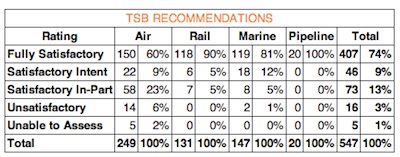
News
TSB calls for swifter action on safety concerns
May 10, Gatineau, Que. - The Transportation Safety Board of Canada (TSB) has released its annual reassessment of responses to Board recommendations.
May 10, 2013 By Wings Magazine
May 10, Gatineau, Que. – The Transportation Safety Board of Canada (TSB) has released its annual reassessment of responses to Board recommendations. When the TSB identifies serious safety deficiencies during an investigation, it issues recommendations to the regulator or industry, putting a direct spotlight on what needs to be addressed. Troubled by slow progress, the TSB is now calling on Transport Canada to intensify efforts on a number of outstanding safety recommendations, especially in aviation.
"Canadians deserve to be informed about safety, and these reassessments will help them track the progress made by Transport Canada," said Wendy Tadros, Chair of the TSB. "When we see little movement from the regulator on our recommendations, we need to raise the red flag — and that is what we are doing today."
A major challenge remains in aviation which has seen very limited movement on recommendations. Only 60 per cent of recommendations have received the TSB's highest rating of "fully satisfactory". Canada has seen a number of aircraft accidents over the past few years that have involved factors relating to these outstanding recommendations. For instance, the TSB has revived three dormant recommendations relating to post-impact fires as a result of ongoing accident investigations. In addition, not enough is being done to address a recommendation which calls on Transport Canada to require airports with Code 4 runways (1800m) to have a 300m runway end safety area or a means of stopping aircraft that provides an equivalent level of safety — landing accidents and runway overruns are on the TSB Watchlist.
For its part, safety has improved in the marine sector. Five Watchlist-related recommendations have been reassessed as "fully satisfactory." However, a key Watchlist issue that remains unaddressed is the introduction of safety management systems (SMS) for commercial operators of small passenger vessels. SMS is a proven system to help manage risk, and Transport Canada and the marine industry need to take action to make this a reality for small marine operators.
Canada's rail sector also saw some positive activity with two recommendations reassessed as "fully satisfactory" however, safety at railway crossings remains a significant risk. Many of the outstanding recommendations have not been fully addressed and there have been several railway crossing accidents in recent years. Passenger trains colliding with vehicles is on the TSB Watchlist, and the Board continues to press for the introduction of voice and video recorders in locomotives.
"We've seen progress over the past year in some sectors, but we'd like to see even more," added Tadros. "The TSB challenges Transport Canada to work with the transportation industry to advance innovative solutions to address these serious deficiencies. It's in everyone's best interest to take all necessary measures to prevent accidents and losses."
The TSB is an independent agency that investigates marine, pipeline, railway and aviation transportation occurrences. Its sole aim is the advancement of transportation safety. It is not the function of the Board to assign fault or determine civil or criminal liability.

|